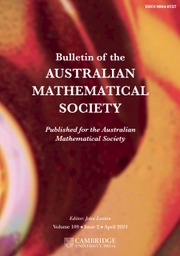No CrossRef data available.
Article contents
THE DENSE REGION IN SCATTERING DIAGRAMS
Published online by Cambridge University Press: 10 February 2025
Abstract
We use deformations and mutations of scattering diagrams to show that a scattering diagram with initial functions  $f_1=(1+tx)^\mu $ and
$f_1=(1+tx)^\mu $ and  $f_2=(1+ty)^\nu $ has a dense region. This answers a question asked by Gross and Pandharipande [‘Quivers, curves, and the tropical vertex’, Port. Math. 67(2) (2010), 211–259] which had been proved only for the case
$f_2=(1+ty)^\nu $ has a dense region. This answers a question asked by Gross and Pandharipande [‘Quivers, curves, and the tropical vertex’, Port. Math. 67(2) (2010), 211–259] which had been proved only for the case  $\mu =\nu $.
$\mu =\nu $.
Information
- Type
- Research Article
- Information
- Copyright
- © The Author(s), 2025. Published by Cambridge University Press on behalf of Australian Mathematical Publishing Association Inc.
Footnotes
This project was financially supported by Mark Gross’ ERC Advanced Grant Mirror Symmetry in Algebraic Geometry (MSAG).
References
Argüz, H. and Gross, M., ‘The higher-dimensional tropical vertex’, Geom. Topol. 26 (2022), 2135–2235.CrossRefGoogle Scholar
Bousseau, P., ‘The quantum tropical vertex’, Geom. Topol. 24(3) (2020), 1297–1379.CrossRefGoogle Scholar
Bousseau, P., ‘Scattering diagrams, stability conditions, and coherent sheaves on
 ${\mathbb{P}}^2$
’, J. Algebraic Geom. 31 (2022), 593–686.CrossRefGoogle Scholar
${\mathbb{P}}^2$
’, J. Algebraic Geom. 31 (2022), 593–686.CrossRefGoogle Scholar
Bousseau, P., Brini, A. and van Garrel, M., ‘Stable maps to Looijenga pairs’, Geom. Topol. 28 (2024), 393–496.CrossRefGoogle Scholar
Bridgeland, T., ‘Scattering diagrams, Hall algebras and stability conditions’, Algebr. Geom. 4(5) (2017), 523–561.CrossRefGoogle Scholar
Gräfnitz, T., ‘Tropical correspondence for smooth del Pezzo log Calabi–Yau pairs’, J. Algebraic Geom. 31(4) (2022), 687–749.CrossRefGoogle Scholar
Gross, M., Hacking, P. and Keel, S., ‘Mirror symmetry for log Calabi–Yau surfaces I’, Publ. Math. Inst. Hautes Études Sci. 122 (2015), 65–168.CrossRefGoogle Scholar
Gross, M., Hacking, P., Keel, S. and Kontsevich, M., ‘Canonical bases for cluster algebras’, J. Amer. Math. Soc. 31(2) (2018), 497–608.CrossRefGoogle Scholar
Gross, M. and Pandharipande, R., ‘Quivers, curves, and the tropical vertex’, Port. Math. 67(2) (2010), 211–259.CrossRefGoogle Scholar
Gross, M., Pandharipande, R. and Siebert, B., ‘The tropical vertex’, Duke Math. J. 153(2) (2010), 297–362.CrossRefGoogle Scholar
Gross, M. and Siebert, B., ‘From real affine geometry to complex geometry’, Ann. of Math. (2) 174(3) (2011), 1301–1428.CrossRefGoogle Scholar
Gross, M. and Siebert, B., ‘The canonical wall structure and intrinsic mirror symmetry’, Invent. Math. 229 (2022), 1101–1202.CrossRefGoogle Scholar
Kontsevich, M. and Soibelman, Y., ‘Affine structures and non-Archimedean analytic spaces’, in: The Unity of Mathematics, Progress in Mathematics, 244 (eds. Etingof, P., Retakh, V. and Singer, I. M.) (Birkhäuser, Boston, MA, 2006), 321–385.Google Scholar
Kontsevich, M. and Soibelman, Y., ‘Stability structures, motivic Donaldson–Thomas invariants and cluster transformations’, Preprint, 2008, arXiv:0811.2435.Google Scholar
Reineke, M., ‘The Harder–Narasimhan system in quantum groups and cohomology of quiver moduli’, Invent. Math. 152 (2003), 349–368.CrossRefGoogle Scholar
Reineke, M., ‘Poisson automorphisms and quiver moduli’, J. Inst. Math. Jussieu 9(3) (2010), 653–667.CrossRefGoogle Scholar
Reineke, M., ‘Cohomology of quiver moduli, functional equations, and integrality of Donaldson–Thomas type invariants’, Compos. Math. 147(3) (2011), 943–964.CrossRefGoogle Scholar
Reineke, M. and Weist, T., ‘Refined GW/Kronecker correspondence’, Math. Ann. 355 (2013), 17–56.CrossRefGoogle Scholar


